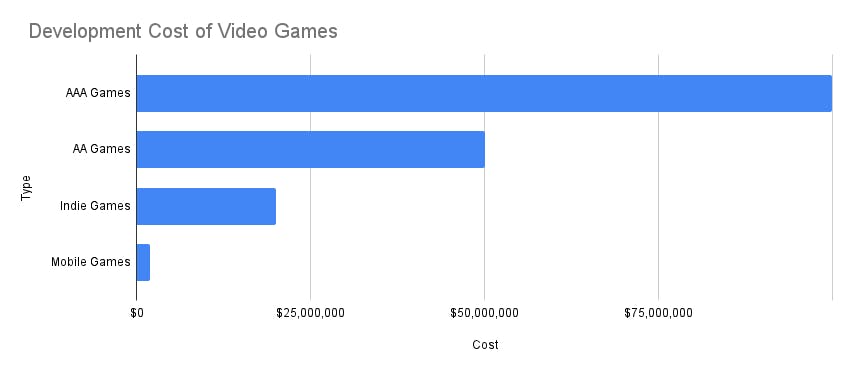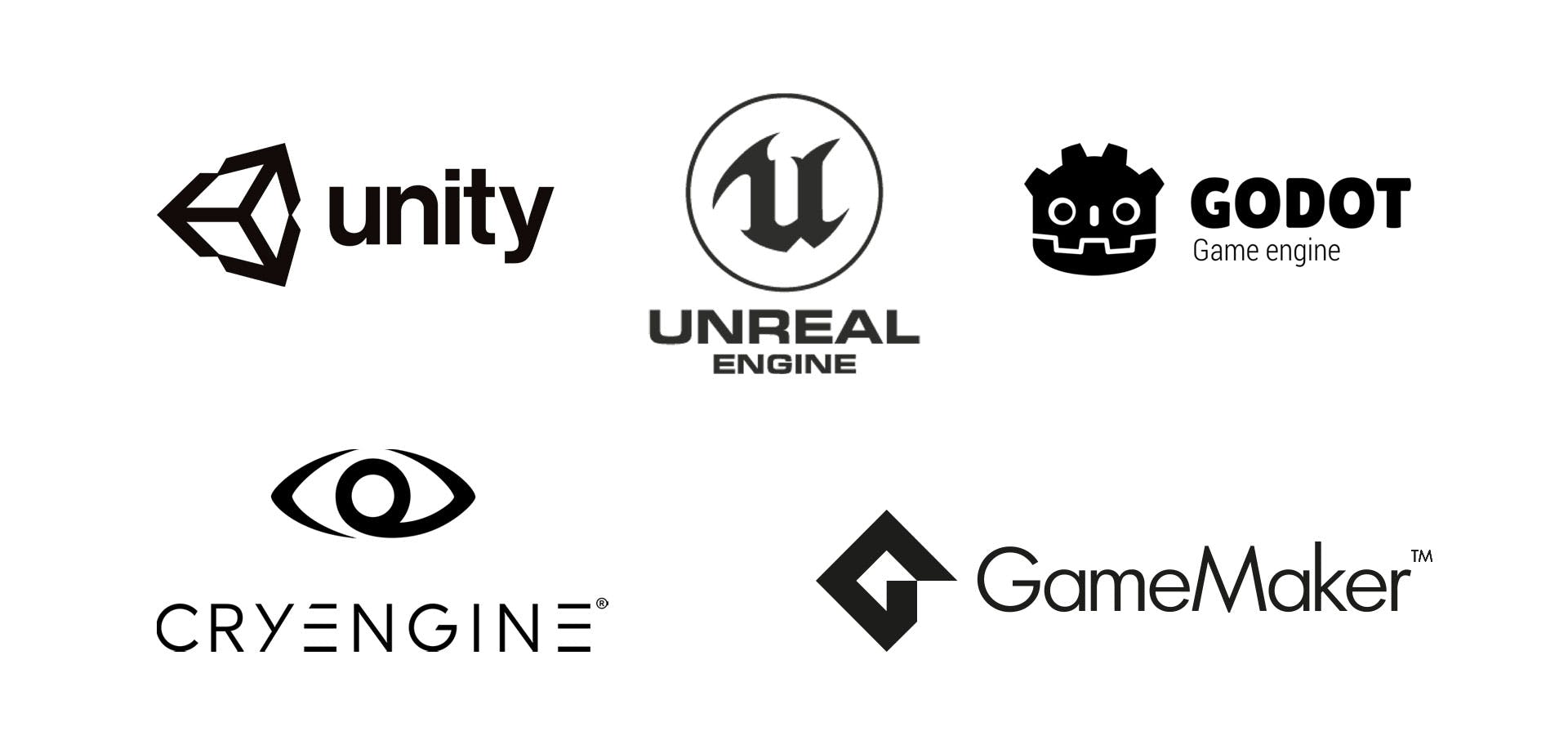Gaming Industry Overview
The term entertainment industry is no longer monopolized by Hollywood and the music and movie industries as games now offer one of the most exciting forms of entertainment in the world. Furthermore, games are no longer just for entertainment, they become more inspiring and influential on culture and social life.
In fact, the video game industry is now bigger than the music and movie industries combined. It currently has an estimated market value of $200 billion and thus it's one of the biggest ingenious tech industries today and continues to grow.
The History of The Gaming Industry
The history of the games industry is long and impressive. It's back when engineers started to create interactive games in the early days of computer science. Let's go through the history of gaming:
- Tennis for Two, one of the earliest video games, was created in 1958 by William Higinbotham. And was played on an oscilloscope.

Pong was the first commercial video game released in 1972, and played on arcade machines, quickly becoming a global game.
The 1970s also saw the release of some of the most iconic video games of all time, including Space Invaders, Pac-Man, and Donkey Kong.

The video game industry crashed in the 1980s. This was due to several factors, including an oversaturated market and the rise of home computers. However, the industry recovered in the 1990s and has continued to grow ever since.
Today, the video game industry is a multi-billion dollar industry. It's one of the most popular forms of entertainment in the world and is constantly evolving.
The Type of Video Games and Development Cost

Many factors can affect the cost and can vary greatly depending on the type of game, the scope of the project, the length of the game, the marketing and distribution, the platform of the game, and the experience of the development team. Also, the more complex the game, the more expensive it will be to develop. Additionally, games designed for consoles generally have higher budgets than games designed for mobile devices. Now, let's take a look at game types and how much they cost:
AAA games: are the most expensive type of video game to develop. They typically have large budgets of $100 million and more, this type of game can take from several years to a decade to complete. Some of the most expensive AAA games ever developed include Grand Theft Auto V, Call of Duty: Modern Warfare 2, The Elder Scrolls V: Skyrim, The Witcher 3: Wild Hunt, Red Dead Redemption 2, Elden Ring, and more.
AA games: AA games are less expensive than AAA games, but they still require a significant investment. They typically have budgets of $10 million to $50 million. Here are some of the popular AA games: A Plague Tale, Hellblade, The Wolf Among Us, and Life Is Strange.
Indie games: are typically less expensive to develop than AA games. They can range in cost from a few thousand dollars to a few million dollars and the time of development same as AAA games, can take anywhere from a year to a decade.
Indie games are often developed by small teams, and they may use more affordable tools and resources that's why they cost less than AAA games. Some popular indie games include Stardew Valley, Cuphead, The Witness, Hollow Knight, and Celeste.
Mobile games can also range in cost from a few thousand dollars to a few million dollars, depending on the complexity of the game, the features it includes, and the platform it's being developed for. Some popular mobile games include Candy Crush Saga, PUBG Mobile, and Genshin Impact.
Gaming Grow to Become The Most Successful Entertainment Sectors
The video game industry has evolved into one of the most successful sectors in the entertainment industry due to several factors, including:
The rise of home consoles: The introduction of home consoles in the 1970s and 1980s made gaming more accessible to people of all ages.
The growth of the Internet: The rise of the Internet in the 1990s and 2000s allowed gamers to connect online.
The increasing power of computers: Increased computing power allows developers to create complex and visually stunning games.
The rise of cross-platform gaming: Video games were typically tied to a specific platform, such as a console or PC. However, in recent years, there has been a trend toward cross-platform gaming, which allows players to play the same game on different platforms.
The rise of mobile gaming: The rise of mobile gaming in the 2010s made gaming easier than ever. This has led to a dramatic increase in the number of people playing video games.
The increasing popularity of video games: The number of people playing video games has increased dramatically in recent years. By 2021, there are an estimated 2.8 billion players worldwide. This growth is due to the increasing availability of gaming consoles, the decrease in the cost of gaming, and the increasing popularity of mobile games
The advancement of technology: This has allowed video game developers to create more immersive and realistic games. This has made video games very popular with many people, including adults.
The rise of esports: Esports or competitive video games have become a worldwide phenomenon. By 2021, the global esports market will be worth more than $1.1 trillion. Esports tournaments are now broadcast live on television and the Internet, attracting millions of viewers. This helped video games rise in popularity and become mainstream.
The increasing acceptance of video games as a legitimate form of entertainment: Video games have traditionally been considered a form of entertainment for children but in recent years video games have gained more acceptance as a legitimate form of entertainment for adults. This is driven by the rise of video games and the increasing number of adults playing video games.
Video Game Development Overview
Video game development is the process of creating video games from the initial concept to the final release, and this process involves many steps, such as game design, programming, art creation, and sound design. And each step requires a unique set of skills.
Game Development Process Stages

The game development process is long and complex, it can take a few weeks to over a decade to develop a game, based on several conditions like the type of game and art. The process can be broken down into five main stages: pre-production, production, Launch, and post-production. Each of these stages can be further divided into several steps. The next description of each stage with its staps:
Pre-production:
This is the planning stage, where come up with the idea for the game and determine the game's scope. Following the steps of this stage:
1- Game concept: This is the first step where you create a blueprint for the rest of the development process. In this step, you create a brief description of the core idea of the game, Such as the type of game, story, characters, gameplay, and setting.
2- Game design document (GDD): As soon as you created a clear game concept, now you need to create a GDD. It should include the key elements of the game and information about the game's concept, gameplay, story, art style, and mechanics.
It's mainly the road map for the team, helps them to stay organized and on track, and ensures that each one knows what they should do, in order to achieve the game objectives.
3- Prototyping: It's creating a small, playable version of a game to test out ideas and mechanics. It can be created using a variety of tools, from simple paper sketches to complex game engines.
Production:
This is the development stage, which turns the concepts created during pre-production into source code, various assets, and adding sound effects and music.
1- Coding: This is when developers start writing the game's code which is the foundation of the game and determines how the game works.
2- Creating art assets: The art assets are the visual elements of the game, such as the characters, environments, and UI. That gives the game its visual identity.
3- Sound design: The sound designers compose the game's music and sound effects to bring a game to life and create an atmosphere to immerse the player in the experience and set the mood.
4- Testing or Playtesting: Test the game to ensure it's working properly, and it's fun and playable. This step includes Alpha, Beta Testing, and many other types of testing. In the end, the testers should provide feedback to the developers.
5- Bug fixing: Fix any errors or glitches based on test results, also, make changes that enhance the game.
Launch:
In this stage, you release the game to the public and this involves marketing and distributing the game.
1- Marketing: Once you finish developing the game, you have to market it to potential players through a variety of channels, such as social media, creating trailers, and running advertising campaigns.
2- Distribution: The game should be distributed to players. This may involve releasing it on digital distribution platforms, through physical retail, and streaming services.
Post-production:
This is the maintenance stage, which continues to support the game after it has been released, fixing bugs, adding new content, or making changes.
1- Bug fixing: After the game has been released it's important to provide post-launch support, this will help to fix any bugs that may be found.
2- Adding new content: Add new content to the game, such as new levels, characters, or features. That will keep players engaged.
3- Making changes: Make changes to the game based on players' feedback.
Game Engines
Developing a game can be a challenging but rewarding experience and choosing the right game engine will help you to create a wide variety of games that you and others will enjoy.
A game engine is a software framework that provides the fundamental components needed to create video games. It includes a rendering engine, physics engine, audio engine, and other components.
There are many different game engines available, each with its own strengths and weaknesses. Following are some of the game engines:
Unreal Engine: Unreal Engine is a powerful game engine that is used to create AAA games. It's known for its high-quality graphics and its ability to create realistic physics simulations.
Unity: Unity is a versatile game engine that is used to create games for a variety of platforms. It's known for its ease of use and its large community of developers.
Godot: Godot is a free and open-source game engine that is becoming increasingly popular. It's known for its ease of use and its powerful features.
CryEngine: CryEngine is a powerful game engine that is known for its realistic graphics. It's used to create games such as Crysis and Far Cry.
Source Engine: Source Engine is a game engine that was developed by Valve. It's used to create games such as Half-Life and Portal.
GameMaker: is a 2D game engine that allows to creation of games using a drag-and-drop interface or a scripting language called Game Maker Language (GML). It's a popular choice for beginners and experienced developers alike, as it's easy to learn and use.

The best game engine for you will depend on your specific needs and preferences. If you are a beginner, then you may want to choose a game engine that is easy to use, such as Unity or Godot. If you are looking for a powerful game engine that can create realistic graphics, then you may want to choose Unreal Engine or CryEngine.
Here are some factors to consider when choosing a game engine:
The type of games you want to create: Some game engines are better suited for certain types of games than others. For example, Unreal Engine is a good choice for creating AAA games, while Unity is a good choice for creating mobile games.
Your experience level: A beginner should choose a game engine that is easy to use, furthermore, experts prefer to opt for a feature-rich game engine.
The platform you want to target: Some game engines are better suited for certain platforms than others. For example, Unreal Engine is a good choice for creating games for PC and consoles, while Unity is a good choice for creating games for mobile devices.
The community: The size of the game engine community can be helpful if you need help with game development.
Future of Video Games
The future of video games is very exciting, with new technologies and trends emerging all the time, video games steadily rising in popularity for years, and the social benefits of video games becoming more apparent. The number of gamers is expected to grow to 3.6 billion by 2025 and it’s not just kids either, 38 percent of gamers are between the ages of 18 and 34 years, and 16 percent are older than 55.
Here are some of the trends that are expected to shape the future of video games:
Virtual reality
Augmented reality
Artificial intelligence
Cloud gaming
High-fidelity graphics
Increasing diversity of games
The metaverse
Overall, the future of video games looks very bright. With new technologies and trends emerging all the time, there is no telling what the future holds for the gaming industry. However, one thing is for sure, video games will continue to be a popular form of entertainment for many years to come and also will become more accessible, as more people have access to high-speed internet and powerful computers.
Final Thought
The gaming industry is a global industry that has a significant economic impact and it's worth billions of dollars. It appeals to a wide range of people and is one of the fastest-growing industries in the world, and it's expected to continue to grow in the coming years.
